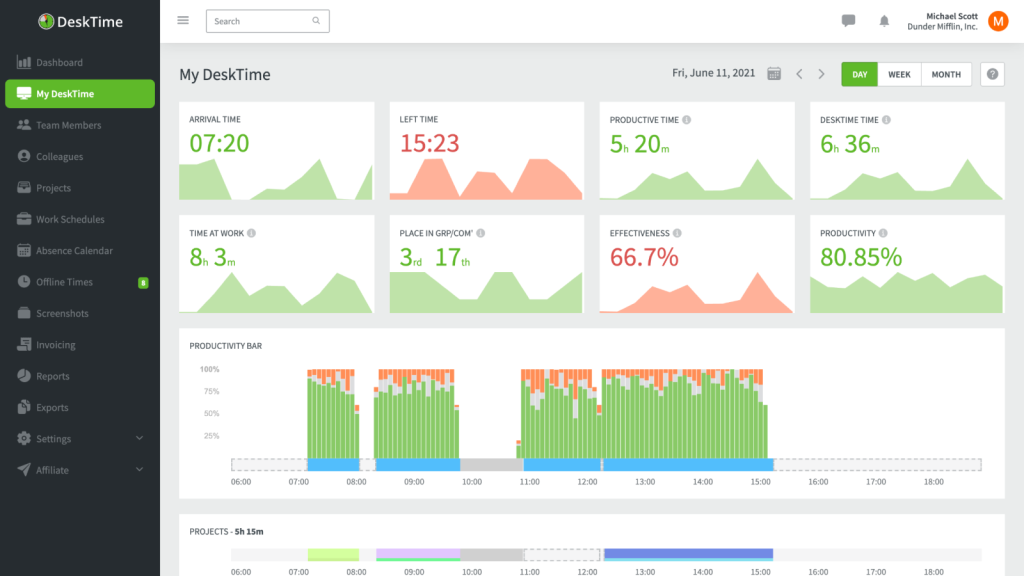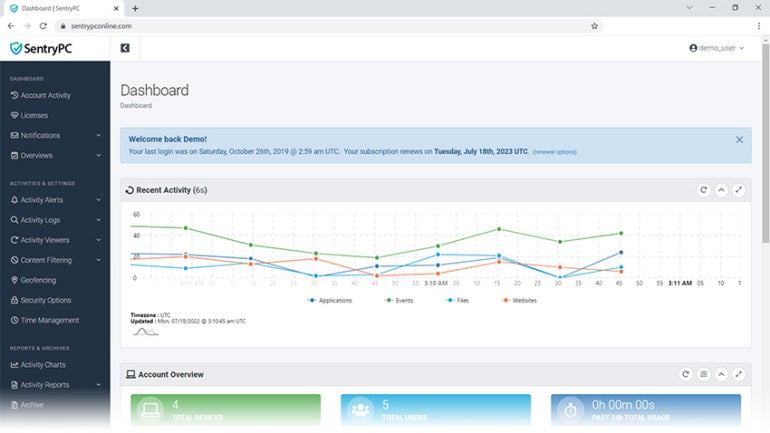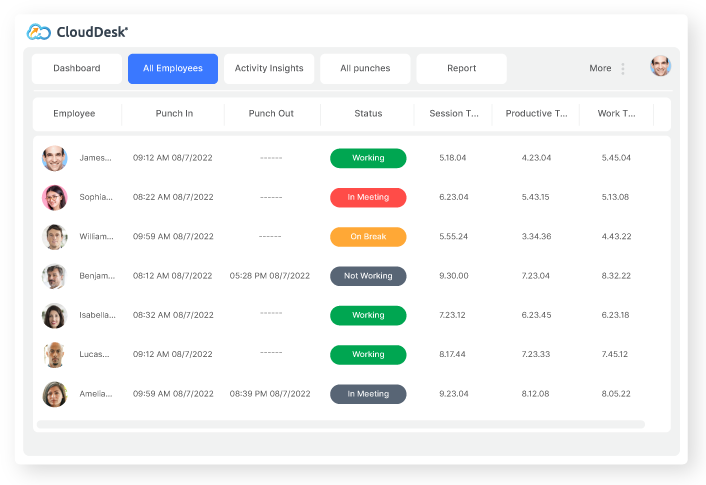The term"employee-monitoring software" is used to describe a software program that organizations utilize to keep track of their employees' actions while they work. Employers are able to collect information about a range of factors associated with employee behavior. This can include internet use, application use, keystrokes and screenshots. The primary purpose of software for monitoring employees is to increase productivity, guarantee conformity with the company's policies, safeguard sensitive information and address security concerns. Several factors should be considered when choosing an employee monitoring software. Remember these essential aspects: Features- Decide the features you need based on the requirements of your business. The most common features are the following: activity monitoring (including website blocking) and keystroke recording (including application usage tracking) and email monitoring and reporting. You should prioritize only those features that are relevant to your monitoring needs.
Security and Compliance: Ensure that the software complies with all ethical and legal guidelines on employee monitoring. Be sure to be familiar with all applicable laws and laws, such as privacy and data protection laws. Software that safeguards privacy for employees must be transparent and customizable settings.
User-Friendliness: Take into consideration the software's usability and accessibility. An intuitive user interface and straightforward installation process will help you save time and ease of implementation. Look into customizable dashboards that include easy-to-use reporting tools to help you quickly navigate and analyze data.
Integration and Compatibility- Verify that the software is seamlessly integrated with your current IT infrastructure as well as the other software you are using including operating systems and email clients, as well as tools for managing projects, as well as collaboration platforms. The software that you are compatible with ensures seamless monitoring and does not interfere with your day-to-day business.
Data Security- Review the security measures of your software in order to ensure safety of the collected data. It is vital to employ encryption, secure storage of data and access controls. Make sure that the software vendor offers strong data protection and security protocols.
Scalability - Take into account the software's capacity to grow with your business. Select software that is easily scaleable to meet your changing needs when you are planning on growing the size of your staff or establishing new offices.
Capabilities for Analytical and Reporting Examine the reporting and analytical capabilities of the software. Consider features that can give a complete view of employee performance, patterns and time allocation. Customized reports and analytics can assist you in making educated decisions, and identify areas of improvement.
Customer Support: Examine how well the vendor provides customer support. Assess their availability, responsiveness and level of technical support. If you have a competent customer service department They will be able to provide prompt help whenever issues arise.
Cost - Be aware of the pricing model like the one-time cost, a subscription, or depending on usage. Be aware of the cost, and whether there are additional charges for support, upgrades or other features. Balance your budget with the value and features offered.
Transparency and communication with employeesBe transparent and communicate clearly to your employees when it comes to the use and implementation of software for monitoring. Explain clearly the reason the scope and expectations regarding the monitoring. Be sure to address any concerns, and ensure they understand that privacy rights will still be protected.
These aspects will allow you to make a more informed choice about the employee monitoring software to select. Check out the top rated employee monitoring services for blog examples.

What Are The Strengths And Features Of The Software For Tracking Employees?
The software for monitoring employees comes with many features to monitor and analyse employee activities. The specific features may vary among different software options However, here are a few commonly used features in the employee monitoring software: Activity Monitoring- This feature captures and records the activities of employees such as sites visited, apps used as well as the files that are accessed and the time spent on each task. It gives a comprehensive description of the activities employees engage in at work.
Keystroke Recording- Keystroke recorders can capture every keystroke made by a worker. It is useful for identifying productivity bottlenecks, detecting unauthorized activities and gathering evidence in the event of an investigation.
Screenshots and screen recordingsScreenshots and screen recordings are captured by some applications of a computer screen at predetermined intervals. Some record their screens in real-time. This feature is used to monitor the efficiency of employees, verify compliance, or troubleshoot issues.
Internet Usage Tracking This feature allows employees to track their online activities, including the websites they visit, the searches they conduct and downloads. It helps identify excessive non-work-related browsing, potential security risks, or policy violations.
This feature tracks all apps that employees use at work. It helps to identify unapproved and excessive application usage by providing insights into the applications frequently used.
Email Monitoring - Email monitoring allows employers to monitor employee emails, including sent and received messages attachments, messages, and email content. It's a great way to ensure compliance with company policies to safeguard data and uncover suspicious activity.
Tracking Documents and Files- This feature tracks file access as well as modifications and transfers. It protects sensitive data as well as monitor document collaboration.
Remote Monitoring is a function that allows employers to monitor their employees, even if they are working from afar or at different places. Employers can track their work and increase efficiency regardless of physical location.
Productivity Analysis: Employee monitoring software usually includes productivity analysis tools, which provide insights into employee productivity working patterns, work patterns, as well as time allocation. These analyses can be used to improve workflow and pinpoint areas of improvement.
Reporting and Analytics - Rich analytics and reporting tools create elaborate reports that contain visualizations of data collected. These reports offer valuable insight about employee performance and the distribution of resources.
Compliance and Policy Management: Some software solutions have features that guarantee the compliance of both the corporate regulations and industry standards. Employers are able to establish and enforce policies of their company on acceptable computer usage.
Alerts/Notifications: Alerts/notifications alert employers or managers when certain events or activities occur. They are able to notify you of any suspicious behaviors, such as excessive internet usage or attempts to access restricted websites.
It is important to be aware that different employee monitoring software may have different functions and features. When choosing a software, be certain that the features you choose are in line with your monitoring goals as well as complying with any legal or ethical guidelines applicable to your jurisdiction. See the recommended employee monitoring company for blog recommendations.

What Is The Best Software For Monitoring Employees? Comply With The Compliance And Privacy Law?
It is crucial that the software used for monitoring employees adheres to compliance and data privacy laws. While the specific legal requirements may vary by jurisdiction there are a few common methods that employees monitoring software is in compliance with privacy and compliance regulations: Consent and Notice - Many areas require employees to provide informed consent and receive prior notice of any monitoring activities. The programs that monitor employees often have features that help employers clearly communicate monitoring policies with employees. This could involve giving written notices, getting the consent of consent forms, or creating a handbook for employees which outlines the monitoring procedures.
Transparent Monitoring Policies: Transparent monitoring policy encourage transparency by informing employees of the type of information being collected, why they're being monitored, and how extensive the monitoring is. A clear and complete policy helps employees know the limits of monitoring and their privacy rights.
Data Minimization: To be in compliance with privacy regulations employees monitoring software usually employs data minimization principles. This means only required data is collected and retained. Irrelevant or excessive data are eliminated. The software limits the data collection to what is necessary for monitoring, decreasing privacy risks and encouraging compliance.
Anonymization and Aggregation Various employee monitoring software anonymizes / collects data to ensure the security of privacy for employees. Anonymization removes personally identifiable (PII) and makes it impossible for data to be associated to a particular person. Aggregation involves the mixing of data from multiple employees to provide information at a group scale.
Encryption and Secure Data storage - Employee monitoring software places the highest priority on the security of data. Secure data storage and encryption are employed to guard data from access by unauthorized persons or accidental disclosure. It is essential to protect the data during transport as well as at rest.
Access Controls and Restricted Permissions To ensure compliance, employee monitoring software often gives granular access controls and permissions. Employers are able to limit access to the monitoring information to those who need it legally, such as HR personnel or administrators.
Employee Rights: The right to respect employees' rights is essential to comply with compliance and privacy laws. Software for employee monitoring often comes with features that permit employees to access their monitoring data, ask for corrections, and file complaints. Employees have the option to seek recourse in case of privacy violation and to exercise their rights.
Conformity with Data Protection Regulations - Employee monitoring software was developed to comply with data protection regulations like the General Data Protection Regulation in the European Union (GDPR) or the California Consumer Privacy Act in the United States (CCPA). Compliance is achieved by implementing appropriate measures to safeguard personal information, ensuring data subjects rights, and making sure the data used is lawful. data.
It is important to note that while employee monitoring can help organizations comply with laws and regulations however, they must be sure to consult with lawyers and stay up to date on local laws and regulations. A comprehensive strategy for complying with privacy and compliance laws is essential, and is more than just software. It includes clearly defined policies, along with training employees and continuous monitoring. Have a look at the recommended time tracking monitoring services for website examples.
